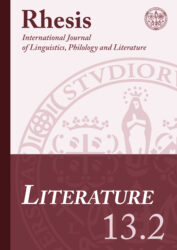 Literature
LiteratureVol. 1.2 - 2010
Download issue
Table of contents
| p. 5 | From Dream to Despair: The Ironies of the Great Migration in William Attaway’s Blood on the ForgeDaouda CoulibalyAbstract Often assimilated to «urban realism» of the 1940s, William Attaway’s Blood on the Forge resists such a classification. Unlike the violent modes of protest literature wherein the individual confronts headlong the white racist system, Attaway uses irony to subvert the racist determination of African American subjectivity. The novel dramatizes the trauma of racism and segregation with which the Moss brothers are confronted. In their attempt to escape from the sharecropping system and its economic and racial oppression, Attaway’s protagonists leave rural Kentucky (South) for the steel mill town in the North. Instead of the better future such a move might imply, Attaway’s characters suffer and they are either crippled or killed at the end of the novel. This article argues that the condition of the characters is ironic in that they lose in the North the human qualities they brought with them from the South. The purpose of this study is not so much to break new ground but rather to promote a productive reading of Attaway and give him the place he deserves in African American literature.
|
| p. 15 | A la recherche de l’energia des lettres et des mots: étude stylistique de Queen of Dreams de Chitra Banerjee DivakaruniLaurence GouauxAbstract As an American writer of Indian descent, Chitra Banerjee Divakaruni knows how to give her words and letters a special energy inherited from Hinduism. For example, the letter S allows one of the main characters to invoke Ananta, the Cosmic Serpent, and to keep acquainted with a knowledge and a vision inherited from ancient ages. That is the reason why the theoretical framework used here to analyse this novel will draw both from traditional rhetoric and Hindu symbolism, thus bridging the gap between western and eastern cultures.
|
| p. 24 | Kamala Markandaya's A Silence of Desire and Possession (Exploring Psychological Dimensions of Spirituality)Naveen K. MethaAbstract Kamala Markandaya belonged to that pioneering group of Indian women writers who made their mark not just through their subject matter, but also through their fluid, polished fictional technique. The works of Kamala Markandaya reflect the modern, traditional and spiritual values of the Indian societies. Her characters represent these values in a very subtle manner. The psychological conflict in Kamala Markandaya’s A Silence of Desire takes its roots in the basic opposition between Sarojini’s unreasoned belief in the healing faculty of the Swamy and Dandekar’s rational belief to disapprove it whereas in Possession Vals journey through negative freedom and an escape from responsibility to the self-realization reveals his psychic problems. The present paper is an attempt to explore the psychological dimensions of spirituality in Kamala Markandaya‟s A Silence of Desire. and Possession.
|
Tags: America, Daouda Coulibaly, energia, faith, Hinduism, irony, karman, Laurence Gouaux, letters, Naveen K. Metha, North/ South, possession, psychology, spirituality, subjectivity, trauma, violence, words
 LiteratureVol. 1.2 - 2010
LiteratureVol. 1.2 - 2010
